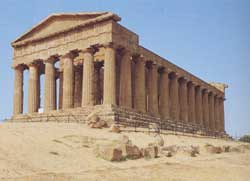Home - In and around
UNESCO: ARCHAEOLOGICAL AREA OF AGRIGENTO
Founded as a Greek colony in the 6th century B.C., Agrigento became one of the leading cities in the Mediterranean world. Its supremacy and pride are demonstrated by the remains of the magnificent Doric temples that dominate the ancient town, much of which still lies intact under today's fields and orchards. Selected excavated areas throw light on the later Hellenistic and Roman town and the burial practices of its early Christian inhabitants.
The archaeological area of Agrigento, the Valley of the Temples, is on the southern coast of Sicily and covers the vast territory of the ancient polis, from the Rupe Atenea to the acropolis of the original ancient city, as well as to the sacred hill on which stand the main Doric temples and up to the extramural necropolis.
The archaeological area of Agrigento includes all the essential elements that contribute to the justification of its Outstanding Universal Value. The site boundary includes the entire territory of the ancient polis, including the extramural area of the necropolis, the substantial excavated areas of the residential area of Hellenistic and Roman Agrigento, the complex network of underground aqueducts and a wide portion of land where there are still unexcavated archaeological structures. The archaeological structures have been preserved in good condition, thus ensuring an authentic representation. However, land instability remains an issue.
The archaeological area of Agrigento, the Valley of the Temples, is on the southern coast of Sicily and covers the vast territory of the ancient polis, from the Rupe Atenea to the acropolis of the original ancient city, as well as to the sacred hill on which stand the main Doric temples and up to the extramural necropolis.
The archaeological area of Agrigento includes all the essential elements that contribute to the justification of its Outstanding Universal Value. The site boundary includes the entire territory of the ancient polis, including the extramural area of the necropolis, the substantial excavated areas of the residential area of Hellenistic and Roman Agrigento, the complex network of underground aqueducts and a wide portion of land where there are still unexcavated archaeological structures. The archaeological structures have been preserved in good condition, thus ensuring an authentic representation. However, land instability remains an issue.



